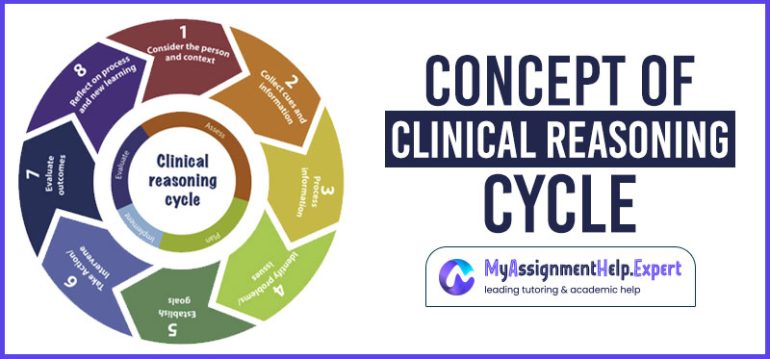An Insight into the Concept of Clinical Reasoning Cycle

Medical professionals are expected to be responsible for their actions. One mistake and someone’s life will be at stake. They must look into all the aspects to suggest remedies and help patients recover rapidly.
The clinical reasoning cycle is one of the most important things in the profession. The professionals use the cycle to make sure patients undergo the right treatment. For students who aspire to be in the profession, it is important for them to learn every step of the cycle.
The cycle, developed by Tracy-Levett Jones, focuses on the aspect of critical thinking and problem-solving abilities. Reasoning, rationalising, transparency, thoroughness, honesty, truthfulness and justice are some of the characteristics that are crucial for proper execution of the cycle.
If you look around, you will get a lot of examples where the cycle has been used. In fact, if you go to a doctor, you will have to answer a few questions before the doctor writes a prescription. The entire process can be termed a clinical reasoning cycle. This blog will take a deep dive into the concept and help you learn all about it.
Let’s get started!
What Is the Clinical Reasoning?
When a patient comes for a medical checkup, medical professionals do not prescribe medicines without listening to them. Now, what do they ask, and why is it necessary? To begin with, medical professionals need to understand the problem before they plan a solution.
So, if you have a stomach ache, the doctor will ask a few questions before prescribing any medicines. While most of you get impatient, it is important to understand how your answer plays a crucial role in the process. The entire process is a clinical reasoning cycle, from collecting facts to suggesting a remedy.
However, there are quite a few stages, and professionals can make changes in the process as and when necessary. On that note, let’s understand the 8 stages of the clinical reasoning cycle in the following section.
The 8 Phases of Clinical Reasoning Cycle
You need to know the various stages of the clinical reasoning cycle for a better understanding. Here’s an insight into the eight phases of the cycle:
1. Consideration of facts
The first phase of the clinical reasoning cycle is where you present the information and the patient’s current condition. It is one of the crucial phases of the cycle. You cannot make any mistakes in this phase. The entire treatment and the progress of the cycle depend on the initial information.
2. Collection of information
Nurses are expected to consider the past medical history of the patient, look at the history of presenting complaints, and the treatment they are undergoing presently to move forward with the process. You must also closely examine the results of investigations and the present vital signs to make an informed decision.
3. Processing gathered information
Processing gathered information is one of the crucial steps of the process. Medical professionals look into the current condition in relation to pathophysiological and pharmacological patterns. They ensure to process of relevant details in this phase. It helps them find the right methods of treatment and determine potential outcomes. This phase affects the entire decision-making process.
4. Identifying the problem
Medical professionals need to know the correct reasons behind the current condition of patients. An effective information processing phase leads to the correct identification of problems. If you aspire to be a nurse, ensure you have a proper understanding of the cycle and use each data properly. You must be responsible for helping patients recover quickly and know the best ways to process information.
5. Establish goals
Nurses need to find out the correct method of treating patients. You need to plan the entire treatment process. So, after you have identified the problem, you need to establish goals. There’s no need to set a time for treatment. Instead, you must mention the necessary steps to take and how fast you want to reach your goals.
6. Take action
Once you have planned the entire process, it is time to put them into action. You cannot do the entire thing by yourself. It is important to involve other members of the healthcare team in this phase. You need to update everyone about the treatment goals and work on the same accordingly.
7. Evaluation
It is not recommended to go ahead with the process without evaluating the steps. You need to look into the steps again and understand if that is the best way to go about it. If there’s a need, consider readjusting the steps, or else go ahead with the line of action. It is always better to involve your seniors and peers for better evaluation.
8. Reflection
The last phase of the cycle is where you talk about your learnings. Also, it will reflect your skills and how you took the right steps to fulfil your goals. You must also reflect on the things that you could have done differently for a better outcome. Further, it points out the things that must be avoided in similar cases in the future.
The clinical reasoning cycle is one of the most important processes in healthcare. For students who aspire to be a nurse in the future, it is crucial to understand the various aspects of the process. Wondering why is the clinical reasoning cycle important? Let’s take a look.
Significance of Clinical Reasoning Cycle
Healthcare professionals need to put their foot forward very cautiously. Their one mistake can make things worse for patients. They are held responsible in case a patient’s health deteriorates. The clinical reasoning cycle helps healthcare professionals plan things well and take steps accordingly.
The cycle takes into account all the steps from the beginning till the end. The professionals need to understand each aspect before deciding on a treatment plan. It is necessary to understand a patient’s present health condition before suggesting a treatment.
Nurses look into the medical conditions based on past data and suggest treatment accordingly. They must check all the details before moving forward with the process. Failing to identify the medical condition can lead to major problems in the long run. Students pursuing the subject must consider learning the lesson well for better opportunities in the future.
The clinical reasoning cycle has always been important in healthcare. You need to understand how it is important to treat a patient and follow the stages accordingly. It is crucial to know the best ways to treat patients and work on the process accordingly.
The 7 Types of Clinical Reasoning
You need to know the various types of clinical reasoning. The process is crucial in healthcare, and you need to understand everything about it. Let’s take a look at the seven types of clinical reasoning:
You need to know the various types of clinical reasoning. The process is crucial in healthcare, and you need to understand everything about it. Let’s take a look at the seven types of clinical reasoning:
1. Scientific reasoning
Scientific reasoning focuses on various facts. One needs to consider various things such as impairments, disabilities and performance context. The type can be used to identify the problems and find the best solutions.
2. Diagnostic reasoning
Diagnostic reasoning is directly related to the client’s diagnosis and the ways the same can affect the clinical picture. This type is sometimes considered a part of scientific reasoning.
3. Procedural reasoning
Nurses need to answer a lot of questions before suggesting a remedy. The type focuses on what, when, and how interventions and suggests solutions accordingly. It is mainly focused on the therapy process.
4. Narrative and interactive reasoning
Healthcare professionals also undertake storytelling processes to identify problems and find solutions. The type is focused on interaction between client and therapist for a better understanding of the situation.
5. Pragmatic reasoning
Medical professionals need to consider costs, time, the therapist’s skills, client wishes, and physical location. Nurses can take a deeper look at the problems and contexts, focussing on developing practical and realistic solutions.
6. Ethical reasoning
Nurses need to consider a lot of things before suggesting a solution. They are expected to consider the right and wrong sides of the problem. This helps develop the best and the most moral solution to a problem.
7. Conditional reasoning
It is one of the most complex types in the entire list. Nurses are expected to gain an empathetic understanding of the situation along with finding a resolution. The type takes into account the other types of reasoning to create a framework to select the right course of action.
Budding nurses are expected to learn all the aspects of the clinical reasoning cycle to be successful in the field. Let’s understand the three key elements of clinical reasoning.
The Three Elements of Clinical Nursing
To understand clinical reasoning and for proper application, you need to learn and implement the three key elements. Nurses deal with a lot of pressure, and it is not easy to keep everything in mind. However, as the responsibilities are bestowed upon them, it becomes crucial to find ways to take care of the patients. The proper application of the clinical reasoning cycle depends on these three elements:
1. Analysis of data
The first thing you need to keep in mind is analyzing the data. For example, if a patient complains about pain in the leg, you cannot simply send them away by prescribing painkillers. Instead, you need to sit and listen to the reason behind the pain to find the right remedies. You need to go through the patient’s medical history and look into all the aspects before formulating a plan.
2. Using specific knowledge bases
Will you ever go back to a medical professional who fails to understand your illness and suggests wrong solutions? Definitely not. Medical professionals are expected to be aware of various diseases. Yet, not all of them are specialists. Hence, when a nurse looks into a new case, it is expected of them to use their knowledge and prescribe medicines. They must also consult with a specialist before formulating a plan.
3. Synthesis of process and information
Connecting the dots is crucial in the entire process. Nurses are expected to look into the case properly. They must check the initial stages, the symptoms, etc., to ensure a proper synthesis of process and information. Medical professionals are always under pressure and are often handling multiple cases simultaneously. So, synthesising process and information is important in the entire process.
As the clinical reasoning cycle is crucial in the medical profession, nurses need to acknowledge the three elements. One needs to understand how the process can be implemented and work on each step accordingly.
Final Thoughts,
The entire medical profession depends on the proper diagnosis of diseases. The clinical reasoning cycle needs to be used correctly for effective monitoring and treatment of patients. All of us depend on healthcare professionals for our well-being. So, if you want to take up the responsibility, go through the lessons well and implement each stage correctly in practical life.
Frequently Asked Questions By Students-
1. How does the clinical reasoning cycle contribute to better patient care?
Ans: The clinical reasoning cycle aims to help medical practitioners better diagnose their patients. Nurses with a proper understanding of the clinical reasoning cycle are able to diagnose diseases on time and suggest proper treatment methods. It helps in avoiding unnecessary investigations, thus reducing costs to patients and improving patient’s health.
2. How do healthcare professionals process the information during the clinical reasoning cycle?
Ans: The data collected by healthcare professionals are processed by looking at the patient’s current health conditions. The professionals look at pathological and pharmacological patterns based on the patient’s current health status. They filter out the necessary information to determine the potential outcomes of the decisions they make. It is one of the best ways to treat patients, and nurses must have the right knowledge to make informed decisions.
3. What is the significance of ‘collect cues and information’ in clinical reasoning?
Ans: Medical professionals need to be extra cautious about the entire treatment process. Collecting cues and information is an important stage in the clinical reasoning process. The treatment is based on the proper understanding of health conditions. The cues and information help nurses make proper decisions and can lead to faster recovery of patients.
4. Can you provide examples of how cues and information are analyzed in the clinical reasoning cycle?
Ans: Analysing cues is one of the crucial steps of the clinical reasoning cycle. Nurses look into all the client data to understand what they mean. For instance, they can look at some data that are consistent and show the occurrence of common diseases and disorders. They also look at the potential risks the client may face based on the assessment data. The entire process helps professionals find the right treatment methods for a quick recovery of patients.
5. How does experience influence the effectiveness of clinical reasoning?
Ans: Nurses who are experienced can make better decisions without wasting time. Clinical decision-making is based on experience, awareness, knowledge, and information gathering using the right tools. Therefore, the ones with more experience have a better understanding of clinical reasoning and are able to collect information faster and suggest correct treatment methods.
6. Is the clinical reasoning cycle a linear process, or can it be iterative?
Ans: The clinical reasoning cycle is not a linear process. It can be conceptualized as a series or spiral of linked and ongoing clinical encounters. You need to understand the grounds on which the entire cycle is based and work on the same accordingly. Nurses must understand the cycle properly before putting them into practice.






